Editor of this issue: Antanas Klimas
Copyright © 1979 LITUANUS Foundation, Inc.

|
LITUANUS
LITHUANIAN QUARTERLY JOURNAL OF ARTS AND SCIENCES
Volume 25, No.4 - Winter 1979
Editor of this issue: Antanas Klimas ISSN 0024-5089
Copyright © 1979 LITUANUS Foundation, Inc. |

|
RELICT FORMS OF BALTS' NATIONAL COSTUME
ALICJE BEDNARCZUK
I. Introduction
The contemporary representative national costume, particularly female, in certain regions of Lithuania, Latvia and also the neighbouring Estonia suggests in many elements a number of retrospective associations which sometimes date back to distant archeological past.
It concerns certain type of jewelry, i. e., clasps of disk-like and semicircular shape, clanging finery, diadems and female coverlets of villaine type.
As it seems, the numerous archaisms in the culture of the contemporary Balts can be explained on the background of delimited areas of culture influences of East and West, and on the other hand, on the background of specific conservatism of North-East Europe.
In the period between the Wars and after the World War II, Polish etnographers and anthropologists widely discussed the so-called northeastern ethnographical border-land(1). It was delimited on the ground of its individual character of material and mental culture in comparison with the remaining regions of Poland. This definite borderland was outlined as a result of contacting two separate ethnical and cultural groups. The eminent representative of Polish anthropology J. Czekanowski(2) put forward a hypothesis that borderland is a consequence of breaking of the Balto-Slavonic group, which seems justified if we consider the deep motivation of archeology and linguistics.
In further argumentation let us establish that this break was distinctly marked in the Bronze Age, in the period of expansion of Lusatian Culture (1400-300 B. C.) which in its further development incorporated the Proto-Slavonic group as a matter of fact not embracing the Proto-Baltic one.
The conventional Proto-Balts living about 1500 B. C. still archeologically differentiated should be placed in the area from Nemunas to Oka, but not yet reaching the Baltic coast.
It is not, however, the main subject of this article to derive strictly ethno-genetic questions. It is only a matter of drawing attention to the fact that during the investigation of both the genesis and the function of very old products of culture and their relict shape in the present day, one of the research methods could be their examination on the background of ethno-genetic processes. It is because the moment of appearance of a given product, its performing certain function and its transformation or disappearance can become visible in the following aspects of ethno-genesis:
1) substratum, i. e., the original cultural and racial basis,
2) the area,
3) period,
4) influences and diffusion up to the moment when a uniform ethnical group begins to emerge.
When analysing the relict cultural phenomena, we should treat the basin of the Baltic Sea integrally, as an area of the same currents and influences. A great uniting role may be ascribed to the peoples of the Jutland Peninsula and generally to Scandinavia, beginning from the Neolithic Age up to early Middle Ages.
II. Formal and genetic analysis of embellishments
The last phases of the Neolithic Age in North-East Europe characterized by the expansion of string pottery and battle axe (2500-1700 B. C.) according to the majority of archeologists completed the process of Indo-Europeization of those territories. Within the northern, north-eastern and eastern area of that culture, we can see the ancestors of the Germans, Balts and Slavs. On the Southern and Eastern coasts of the Baltic Sea, on the common old substratum of the culture of hunters and pickers i. e. bearers of pit and comb pottery considered as Proto-Ugro-Finnish local cultures were formed, having elements of agriculture.
In the central Pomerania arose the culture of Rzucewo and that of Narva-Nemunas, the latter embracing also the territory of the old Jatvingia, Lithuania, Latvia and part of Estonia. It is already in this period that the archeologists state on the area of the above mentioned cultures a high technical and artistic level of amberworking for decoration, the center of this production being the Curonian Coast. To the common embellishment of that period in Pomerania and the Eastern coast of the Baltic belonged small amber disks, less frequently ovals, with lenticular cross-section. A similar type amber disks occurred in Poland in the region of Kujawy, within the culture of bell-shaped amphoras which was developing there.(3)
Their size usually reached from 4,5 to 6 cm across and 0.6 to 2 cm thick. They were ornamented with a simple geometric motive composed of tiny point-like indents, often filled with white incrustation. The ornament represented an isosceles cross, a decoration by means of two rows of indents on the circumference of the disc or a zigzag. The holes drilled through the centers of the disks prove that they were worn as pendants or amulets. The small amber and bone-disks for hanging around the neck were also known in the group of Zlocko in the area of Unietyce and they are interpreted by archeologists as the emblems of the solar cult. The culture of Unietyce in the zone of Bohemia and West-Central Poland in the last phase of the Neolithic Age played a great role in the intermediation of exchange between the Baltic and the Aegean world. The Baltic amber buttons were the subject of exchange and they were sometimes found in Mycenaean royal tombs.
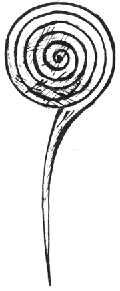
Leading motive of embellishments in the Bronze Age on the Baltic coast.
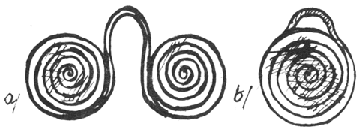
Disk-like finery of the Bronze Age and early Iron Age a) Sambia b) Samogitia
In the beginning of the Bronze Age the pivot of mutual influence of two centers of production; eastern and western is the region of the lower Vistula river.
The Pomerania was, as before, under the influence of Unietyce culture through which greater and greater abundance of bronze finery came there from the basin of the Mediterranean Sea.
The predominant form of import is disk-like finery of bronze wire in the shape of helix 5.5 to 13.5 cm across and also armlets of flat bronze tape having at both ends similar helices. This style began to dominate in the Polish territory throughout the period of Lusatian Culture, penetrating also to the culture of the Balts, for whom it was for centuries a creative inspiration from the Iron Age till the early Middle Ages.
The spiral pins appear in the 3rd period of the Bronze Age (1400-1250 B. C.), mainly in Pomerania but also along the eastern and western coasts of the Baltic Sea, i.e., in the Sambian Peninsula, on the Samogitian coast and on the Gotland as well as in Brandenburg and on the Rügen island.
Judging by the greatest accumulation of this type of finery in Pomerania, many scholars suspect them to be of local provenience.
Towards the end of the Bronze Age, genetically approximate to the spiral type embellishments was small hanging finery occurring mainly in Sambia, on the Samogitian coast (the region of Kretinga) and in Latvia (the region of Riga). It served as hanging forehead decoration in a diadem and continued to be used till the late Roman Period.
Back to the Pre-Lusatian Culture of the Baltic area, date the diadems made of bronze sheet, decorated with point or button ornamentation, i.e., by means of punching technique. A diadem of this type from the 4th period of the Bronze Age was found in Svietlogorsk(4) (Sambia) and it has its analogy in the remains of the Trzciniec and Pre-Lusatian Cultures in the Polish territory. The diademthe most ceremonial adornment of the head widely known all over the ancient world, used to be put on the head in the most sublime moments. With the Balts in the beginning of the Iron Age and in the early Middle Ages the diadem underwent various transformations and assumed very rich external form.
Another zone of cultural influence on the south-eastern coast of the Baltic in the Bronze Age, was far-reaching north-eastern copper route(5), which ran to some extent behind the borders of the Balts, along the lines of the Daugava and the Volga, joining with the Ural range, the country of Kazan and the cultures of the Black Sea steppe. The Nordic side activated this barter, stimulating the economy of peoples inhabiting the central and upper river banks of the Volga. In this far-reaching exchange aiming at the acquisition of the Ural copper ore probably participated, but indirectly, the Baltic element and undoubtedly its eastern range.
Now let us discuss the Nordic type of embellishments:
Chronologically, the Nordic imports and inspirations in the Baltic culture are later in relation to the Early Lusatian ones and the centre of their diffusion was South-East Sweden, the Gotland and the Alands. The amber being very popular a number of Nordic imports accumulate mainly on the Sambia. Among the Nordic imports on the southern coasts of the Baltic appear the so-called plate fibulae.(6) Those clasps had the shape of two slightly convex disks sometimes ornamented with concentric circles. They were joined with each other by means of a crosswise axle and additionally strengthened by a spirally coiled wire.(7) At the beginning of the Iron Age, the fibulae in the region of Pomerania underwent further evolution. Towards the close of the 4th sub-period of the Bronze Age on the Sambia a local bronze production centre arose in which the Lusatian influences in the style of embellishments dominated over the Scandinavian ones. In the late Bronze Age along the coast of the Finnish Bay the disk-like pins appeared with a punched motive of concentric rings.
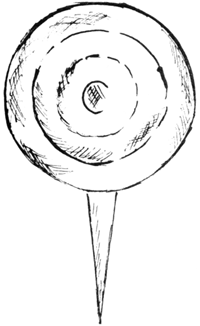
Bronze pin of Nordic type from the end of the Bronze Age Latvia and the Finnish coast.
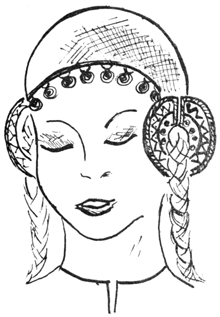
Maidenly head finery from Lithuania of the early Iron Age (1st-5th c. AD).
To other very typical embellishments of the Bronze Age, which occurred in great number in the central Pomerania and in the Baltic area, belonged the round hanging metal finery resembling four-spoked wheels with holes in the middle. In the further stage of its evolution from the beginning of the Iron Age till the early Middle Ages they continued to exist assuming sometimes rich ornamental forms. In the Bronze Age the motive of four-spoked wheel is rather striking on the territory of Central Europe if we consider that in those times only the circle-like wheel was known. Thus the embellishments of a round shape are not only a common imitation of the wheels of a horse-cart or chariot in Asia Minor, but they contain some deeper ideological matter. Therefore one should agree with the suggestions of archeologists that they express the solar cult and maybe also the lunar one.
The above described disk-like embellishments in the Baltic area are for the most part of Lusatian origin, or its specific transposition, and their further metamorphoses found deep reflection in the style of the Baltic finery.
We also see, that in the initial stage of the Lusatian style those embellishments became popular along the Baltic coast, where the Lusatian inspirations were partly adopted by Scandinavia. But were the wearers of those embellishments in the Bronze Age already the ethnical Balts?
From among the Polish archeologists certain proofs concerning the progressive settling of the Proto-Baltic tribes on the Prussian territory in the late Bronze Age were put forward by J. Kostrzewski(8) and recently by J. Antoniewicz(9) and L. Okulicz(10) who declared for the early Iron Age of settling of the Balts in the Prussian territory.
Thus the Bronze Age on the Baltic sea should be treated as a Pre-Baltic cultural substratum, i. e. the old neolithic cultures preserving a certain continuity of material production till the arrival of the ethnical Balts.
This area distinguished itself by greater archaism and traditionalism of culture in comparison with the Polish territory which, in turn, was integrated to a greater extent by the influence from the South. However, the presence of many products of the Lusatian culture not only embellishments, with the Balts, as well as the conditions of infiltration are a separate problem which cannot be solved here.
In this respect the opinions vary: some scholars maintain that the Lusatian culture penetrated to the Baltic area through the mediation of the Venetians, according to others, the Lusatian products and imitations go to the East Baltic lands through mutual trade contacts.
The preservation of the Lusatian style in the embellishments of the Balts for many centuries and epochs and its long continuation similarly as in Pre-Slavonic tribes may prove its great attractiveness. As to the whole Baltic area, however, a great integrating role, as it has already been mentioned, can be seen in the Nordic penetrations.
In the Iron Age the beginning of which for the Baltic area dates back to the half of the first millenium B. C., the disk-like finery of Lusatian type continued to be used. They were mainly pins and coil-shape hanging finery of the diadem, for the most part made of bronze, more rarely of iron. In the period of La Tene and the Roman influences this finery can be found already up to Lithuania.
The very characteristic hanging diadem finery was worn by women together with a metal head-band or it was fastened to little woolen caps. Both the diadems and the caps, according to archeological reconstructions, were worn either separately or together with a white woolen or linen kerchief (the so-called nalęczka). The caps were often set for decoration with small metal plates or buttons. An interesting archeological specimen of this type is the cap from Šernai (the region of Klaipėda) in Lithuania, dating from 1st-4th century A. D. To another version of disk-like embellishments belonged the round temple plaquettes worn on the cap on both sides of the forehead. They were decorated with an ancient ornament of concentric rings and with a motive of incised wire.
The temple plaquettes had sometimes a cut out aperture for the plaits to pass through. According to M. Gimbutas(11) the temple plates were characteristic of western and central Lithuania till the sixth century A.D.
In the woman's barrows of the second century A. D. in Prussia single long plates were also found near the head. They were decorated with the above described ornament of punched concentric rings. They are considered as fragments of diadem head dressing.
The ornamentally punched bronze plates of different dimensions from 3rd to 7th c. A. D. were also a representative decoration of horses' harness. They were also found in tombs of the Jatvingian princes.
The period 2nd-5th c. A. D. is called by M. Gimbutas the Golden Age in the history of the Balts. It is also the epoch of mutual integration of the Baltic culture.
The interest which the Mediterranean world takes in the Baltic amber is still great, therefore the contacts between the Baltic zone and the civilization of the Roman Empire are dynamic and strong. The local artistic crafts attain their great development. The working of noble metals becomes popular as well as silver melting, the art of gilding and enameling. A similar style of enameling becomes popular along the coast of Sweden, Finland, Estonia, in the basin of the upper Dnieper, the basin of the Oka, Volga and Kama, and in the central range of the Ural. Archeologists are trying to state the enameling centres in Europe and they discuss the directions of expansion of this art. Many authors suppose that it was a local Baltic production. According to M. Gimbutas(12) too, the art or enameling developed on the Baltic territory individually, earliest in Prussia (Galindia) between 3rd and 5th c. A.D. and it had its numerous parallels with Kiev.
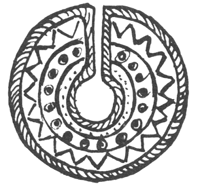
Decorative temple disk from Lithuania.
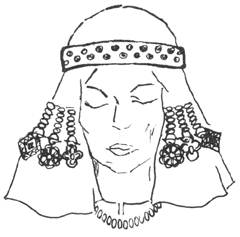
Women's head dressing from Prussia (12th-14th c. AD according R. Odoj (reconstruction)).
The disk-like hanging finery in the shape of four-spoked wheel continue to occur and it undergoes further metamorphoses till the early Middle Ages. With time it takes the form of interestingly ornamented many-spoked wheels and rosettes. Such rosettes often formed the faces of pins on both sides of chain necklaces and they used to be pinned to the vestments on the breast.
The above presented evolution of disk-like embellishments and their continuation through ages leads to the conclusion that the contemporary representative round breast-pins are born of the idea of primitive disk-like embellishments. In some regions of Latvia such breast-pins were not rarely worn and they served also to pin woman's vestments of so-called villaine type. They were also very popular in Estonia.
The large disk-like broaches were a symbol of wealth and social prestige and performed the function of thesaurization, similarly as eg. the genuine coral beads. The diadems in the period of early Middle Ages continue to be a very characteristic and rich part of the clothes. Basing on hitherto known archeological specimens one can state that they have assumed a still richer and at the same time different external form on the respective territory of the Balts. The Lithuanian and Latvian diadems from 6th to 12th c. A. D., as in the Smiltaine region of Ludza and also the Ainava region of Cesis,(13) consisted of several rows of bronze spirals. The Latgalian diadems on the Latvian territory were also enriched with various hanging metal finery such as spangels and trumpet like bells. They were probably parts of young women's ceremonial wedding costume. The diadem from Prussia found in Rownina Dolna near Kętrzyn, dating back to 12th-14th c. A.D. was of a traditional type.(14) It was a wide bronze circlet decorated with punched buttons, put on the head together with a white linen kerchief. On that kerchief on both sides of the face numerous ball shaped bells as well as tin and plumb plaquettes were attached, these last having a round on romboidal shape and being ornamented by engraving.
Can the contemporary Baltic head-dresses be considered as genetic derivatives from diadems similarly as is the case with the head-bands of Slavonic maidens? Here another question arises: is there any genetic relation between the diadems and the high head-dresses of the young women in Estonia and the region of Kurpie in Poland?
In the Venetic period on the Polish territory a typical element of woman's head-dressing were temple-bails. It is a characteristic fact that the Balts did not adopt that finery but they continued wearing the age-long embellishments of their own territory. Only a small number of bails of Pomeranian type were found in women's tombs in Prussia.
The problem of bell-like finery: The small bells, the so-called janizary bells, on the East Prussian territory appeared as imports in the period of Roman influences. According to some archeologists they used to be hung around the sheep's necks. It seems, however, that their destination was different in those times: they were probably adopted as the finery of women's vestments, for an analogical phenomenon of the adaptation of attractive usable objects from the area of the Roman Empire in a miniatured form as finery is known on the Barbaricum. Pendants in the shape of little buckets from the central Pomerania, imitating the imported bronze pails, the so-called sittulae, may be an example here.(15) On the other hand the archeological findings of central Lithuania confirm the presence of janizary bells in women's tombs from 5th to 8th c. A.D. The same type of bells dating back to 12th-14th c. A.D. has been found in the Prussian territory. They used to be worn as necklaces made of alternately strung bells, amber beads and Byzantine crosses.
The formal analysis of the Baltic bell-like finery could show the source of inspiration and the directions of its expansion. One can find analogy between the janizary bell and the Scytian finery from 3rd c. B. C. to 2nd c. A. D.
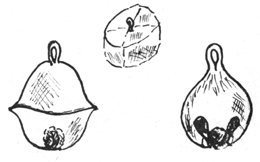
Various forms of janizary bells of the Balts.
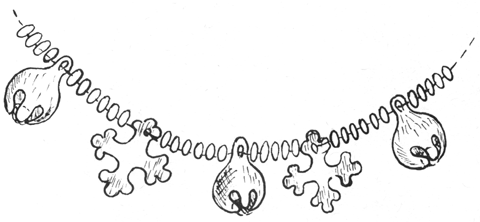
Necklace from Prussia 12th-14th c. AD according to R. Odoj.
The bigger bronze bells of different shapes have been used to this day as elements of shaman's costume in Siberia and they are also worn in the Balkans by wizards, the so-called kukeri in the Rodopi mountains, during the Carnival ceremony. Thus the bells in the finery of the Balts were inspired both by the late Roman Empire and the steppe zone of the East. The bell-like finery was also used for centuries as decoration of horse's bridle.
The fibulae of horse-shoe type: They appear in the Baltic area about the 4th c. A. D. and they continue to be very characteristic finery throughout the whole period of the Middle Ages. Okulicz(16) sees their prototypes in the products from Gaul and the Rhineland, hence probably connected with the Celtic area. In the Baltic territory those fibulae assumed very rich decorative forms. The surface of horse-shoes was plastically formed and ornamented with engraving or punching in the motive of zigzag, resembling the body of a viper. The ends of the fibulae had the shape of buttons, spirals, trumpets or sometimes fantastic animal heads, occasionally filled with coloured enamel. Such finery was worn both by women and men. In the early Middle Ages it must have been the object of exchange by the Balts as they have always been found scattered loosely along the whole Baltic coast. It is an interesting faat that this form of finery is reflected after centuries in the amber from the region of Koszalin. Especially the small amber collar studs in the costume from the village Jamno are worthy of notice (17) They look exactly like the Baltic horse-shoe fibulae from the late Middle Ages. To avoid far-reaching hypotheses as to the genesis of those studs we can confine ourselves to the following alternative: (1) the model-making of horse-shoe fibulae was once brought to the Pomerania and it formally corresponds with the Baltic embellishments, (2) it is a much later type of finery, a kind of talisman, bringing good luck.
In the 13th-15th century the round metal broaches with small holes in the centre became very typical in Lithuania. Their surface was usually slightly convex and it was ornamented with the above mentioned motive of concentric rings or by punching. The idea of the round embellishments threads its way to the present time.
III. The genetic analysis of certain contemporary textile elements of clothes
The typical Lithuanian sashes (juosta) look interesting on the North European background. As far as the methods of workmanship and the composition of motives are concerned, in the Baltic area those sashes territorially show the connections lying evenly with a parallel of latitude. They were woven on a weaver's slat by means of a simple or so-called drawn out stitch, made with two or more warp threads. The technique of multi-harness weaving has been known since the 11th century as the textiles of this kind could be found in barrows and in cultural strata of the Middle Ages: in Scandinavia, on the Gdansk Bay and in Russia. Those sashes representing a large scale of colours and geometrical motives have been worn to this day as a decorative element of both women's and men's regional costume in Lithuania, Latvia and Belorussia. Until quite lately they were made in the region of Masuria and Kashubia of Poland being genetically related with the Lithuanian sashes.
The Latvian villaine is a woolen coverlet worn on the back clasped on the breast by means of a large round broach or thrown over one shoulder and clasped on the hip. To this day it has been a representative part of women's national costume. These coverlets were produced already in the Middle Ages, woven on a horizontal loom on two warps. It resulted in the texture of double structure which consequently was both thick and warm. According to the old tradition in Latvia and Estonia the villaine were decorated with several rows of bronze rings which were also strung on fringes. The prototypes of villaine were found in barrows from 12th-14th c. on the East Baltic area and their analogies occurred in the regions of Novogrod Velikij, Riazan, Smolensk, Kaluga, Moscow as well as in Scandinavia and the island of Gotland. At first they were interpreted as transparent texture of unknown origin. A minute analysis has shown that they are textures on two warps in which the linen warp has undergone decomposition while the woolen structure has been preserved forming characteristic clearances.
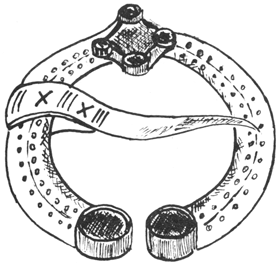
5th c. enamelled horse-shoe clasp from Lithuania according M. Gimbutas.
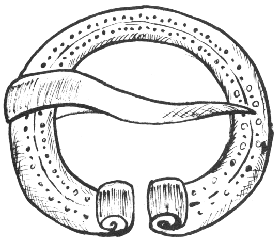
Horse-shoe claspLithuania 9th c. according P. Kulikauskas.
The wearing technique may suggest the expansion of the texture of this type from Flanders, Burgia and the Netherlands to the East. The area of dispersion and the period in which they appeared on the East coast of the Baltic sea and in the Great Russia may suggest that they become popular in that territory during the Norman penetration in 9th-10th c. as the kilims of this type were found in the barrows of the Vikings in Sweden and Norway. It is also not unlikely that this method of weaving was brought from Byzantium to North-East Europe by Varangians-Ruthenians. According to the well-known investigator of the East Europe Turkowski(18) this weaving technique comes from the Moscovian area and earlier it was inspired by the South-East Europe. In the 19th century these methods of weaving were generally adopted by the Lithuanian and Belorussian village and also in dispersed range in North-East Poland, e. g. in the regions of Masuria, Podlasie and partly Kurpie.
We have discussed here the genetic cycle of the Baltic embellishments and textiles which seem to be most characteristic. The criteria of their form and function allow us to arrange them in certain typology while the continuation of products of the same type through centuries and epochs enable us to state their evolutional trends in which one can percept the period of appearance and disappearance of given products. It was our intention to show the relict character of the Baltic costume which can be seen in the revival of ideas of identical or similar ornamental forms and elements in the same or rudimentary function after a period of their seeming disappearance. The archeological material has served us as the main basis of the present description; hence the problems which have been touched here remain open to discussion for archeologists.
1 K. Moszyński, J.
Klimaszewska, Atlas kultury ludowej w Polsce, I-III, Kraków 1934-1936; K. Moszyński, Niektóre przyczyny
zróżnicowania kultury ludowej w
Polsce, Lud Słowiański, IV, B, 65-117; J. Czekanowski, Zróżnicowanie etnograficzne Polski w
świetle
przeszłości, Sprawozdania PAU w
Krakowie, XL (1935), 64-67; Polska synteza slawistyczna w perspektywie
ilościowej,
Kraków 1947; S. Lencewicz, Rubież antropologiczna w
Polsce, Sprawozdania Towarzystwa Naukowego Warszawskiego, XXVIII (1935); A.
Nasz, Etnograficzne aspekty badań archeologicznych w
Polsce, Archeologia, III (1952), 40; J. Gajek, Studia nad etnograficzną regionalizacją
Polski, Lud, XLVII (1962), 165-228.
2 Poska synteza slawistyczna w perspektywie ilościowej, 13.
3 J. Okulicz, Pradzieje ziem pruskich od późnego paleolitu do VII w. n. e.,
Wrocław-Gdańsk 1973, 103-104, 137; J. Szwed, Rola
Bałtyku w dziejach Pomorza Wschodniego w
starożytności,
Wrocław-Gdańsk 1977, 88-89.
4 J. Okulicz, op. cit. 178.
5 L. Okuliczowa, O sadnictwo strefy wschodniobałtyckiej w
I tysiącleciu przed naszą erą, Wrocław-Gdańsk 1976.
6 J. Okulicz, op. cit. 208.
7 M. Sikora, Od okresu epoki brązu do wczesnego podokresu
lateńskiego, Pradzieje Pomorza
Środkowego, Poznań-Słupsk 1975, 66.
8 Stosunki między kulturą łużycką a
bałtyjską a zagadnienie
wspólnoty językowej bałto-słowiańskiej, Slavia Antiqua, V (1956), 21 ff.
9 Problem stref pogranicznych Bałtów ze
Słowianami i Finami w starożytności, Komunikaty
Mazursko-Warmińskie 4-94 (1966), 481-511.
10 Bałtowie we wczesnej epoce
żelaza, Komunikaty . . . 7-107 (1970), 35-38.
11 The Balts, London 1964, 126.
12 Op. cit. 135-136.
13 L. V. Vankina, V. A. Urtan, Latvija v drevnosti, Riga 1967, 54-55, 69.
14 R. Odoj, Sprawozdanie z prac wykopaliskowych przeprowadzonych w Równinie Dolnej pow. K-trzyn w 1956 i 1957 r., Rocznik
Olsztyński, I (1958), 117-154.
15 F. Lachowicz, Podokres lateński i okres
wpływów rzymskich, Pradzieje Pomorza
Środkowego, 119-120.
16 J. Okulicz, Op. cit. 407.
17 A. Dobrowolska, Strój z Jamna pod Koszalinem, Polska Sztuka Ludowa, IX-1 (1955), 52-59.
18 Żrodło
oddziaływań na tkactwo ludowe w
Wileńskiem i
Nowogródzkiem, Londyn 1977.